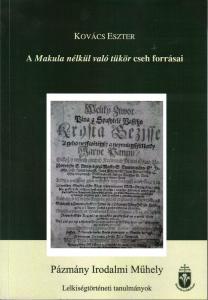
Czech Sources of Makula nélkül való tükör
Czech Sources of Makula nélkül való tükör
Written by Eszter Kovács
NSZL–HAS–Pázmány Péter Catholic University, Budapest, 2014.
[Pázmány Literary Workshop, Studies of History and Spirituality, series edited by László Szelestei N.], 156 pages
ISBN 978 963 308 212 6
Makula nélkül való tükör (“Spotless Mirror”) is a devotional book translated by Clarisse nun Judit Újfalusi at the beginning of the 18th century, and first published in 1712. It was a very popular text of its genre in the 18th and 19th centuries, and important for us not only for the role it played in the Hungarian devotional practice at that time, but also because to our present knowledge, it might have been the first major piece of literary translation from Czech into Hungarian. Eszter Kovács carried out a research on the Czech sources of this work, and to make the relation between the texts even clearer, she thoroughly compared the translation with its supposed Czech source text, Martin z Kochemu: Weliký žiwot Pána a Spasitele… or Martin von Cochem: Das Grosse Leben Christi…. During this comparison, the Hungarian language relics described earlier by Judit Lauf once again stood out, and it was also proved that the Hungarian translator had used other Czech sources as well.
Judit Újfalusi had different principles than her Czech predecessor who believed in an entirely faithful translation of the original without changes whatsoever. The Hungarian nun did not aim at accuracy, instead she followed her own ideas at shortening, complementing and editing the original text, and thus creating an individual literary text of different character. The chapters of the present volume provide an explanation of this translation practice.
Shopping
Our publications are available in our bookshop, or can be ordered from the Publications Department of the NSZL using the contact details below: Főigazgatói Kabinet kiadványtára, Országos Széchényi Könyvtár, 1276 Budapest P.O. box 1205., phone: 06 1 232-3556, e-mail: kiadvanytar@oszk.hu.




